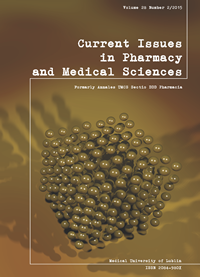Specifics of proximal caries and their diagnostics in posterior teeth
DOI:
https://doi.org/10.1515/cipms-2015-0052Keywords:
posterior teeth, approximal surfaces, caries, diagnostic methodsAbstract
Proximal surfaces are the second in turn after the occlusal surfaces, as being the most exposed places to the carious process. The specificity of changes and location makes the diagnostic of approximal cavities difficult. The aim of the study was to collect information on possibilities of detection, monitoring and assessment of carious lesions located on proximal surfaces, starting from the early stage. On the base of current literature, chosen methods of diagnosis, from conventional, to advanced technologies were presented. Current literature also suggests that none of the diagnostic methods exclude the possibility of misdiagnosis of proximal caries. Therefore, during the diagnosing of doubtful cases, it is advisable to employ several methods of assessment, with simultaneous individual appraisal of caries risk factors, such as oral hygiene, frequency of eating sweets or the number of active caries foci.
References
1. Anusavice K.J.: Present and future approaches for the control of caries. J. Dent. Educ., 69, 538, 2005.
2. Boguszewska-Gutenbaum H. et al.: Rozmieszczenie ubytków próchnicowych na poszczególnych powierzchniach w zębach mlecznych u dzieci do 36 miesiąca życia. Czas. Stomat., 50, 795, 1997.
3. Brown A., Krause F., Jepsen S.: The influence of the calibration mode of a laser fluorescence device on caries detection. Caries Res., 39, 144, 2005.
4. Chłapowska J., Żmijewska C.: Diagnostyka próchnicy powierzchni stycznych w badaniu klinicznym, transiluminacyjnym i radio-logicznym. Stom. Współcz., 6, 32, 1999.
5. Forgie A.H., Pine C.M., Pitts N.B.: The assessment of an intra-oral video camera as an aid to occlusal caries detection. Int. Dent. J., 53, 3, 2003.
6. Haak R., Wicht M.J., Noack M.J.: Conventional, digital and contrast-enhanced bitewing radiographs in the decision to restore approximal carious lesions. Caries Res., 35, 193, 2001.
7. Hintze H: Screening with conventional and digital bite-wing radiography, compared to clinical examination alone for caries detection in low-risk children. Caries Res., 27, 499, 1993.
8. Hintze H., Wenzel A.: Diagnostic outcome of methods frequently used for caries validation. A comparison of clinical examination, radiography and histology following hemi-sectioning and serial tooth sectioning. Caries Res., 37, 115, 2003.
9. Hintze H., Wenzel A., Danielsen B.: Behaviour of approximal carious lesions assessed by clinical examination after tooth separation and radiography: a 2.5- year longitudinal study in young adults. Caries Res., 33, 415, 1999.
10. Huysman M.C, Longbottom C.: The challenges of validating diagnostic methods and selecting appropriate gold standards. J. Dent. Res., 83, C48, 2004.
11. Jędrychowska P., Zarzecka J.: Wybrane, współczesne metody diagnozowania początkowych zmian próchnicowych. Por. Stomat. 6, 22, 2006.
12. Kulczyk T.: Wykrywanie ognisk próchnicy za pomocą zdjęć skrzydłowo-zgryzowych. Mag. Stomat., 14, 31, 2004.
13. Kühnisch J., Bucher K., Hickel R.: The intra/inter-examiner reproducibility of the new DIAGNOdent Pen on occlusal sites. J. Dent., 35, 509, 2007.
14. Lussi A. et al.: Detection of approximal caries with a new laser fluorescence device. Caries Res., 40, 97, 2006.
15. Marsh P., Martin M.: Mikrobiologia jamy ustnej. PWN Warszawa 1994.
16. Maupomé G., Sheiham A.: Decisions on diagnosis and management of approximal caries by final year dental students. Dentomaxillofac. Radiol., 26, 107, 1997.
17. Mirska-Miętek M.: Diagnozowanie zmian próchnicowych na powierzchniach stycznych zębów stałych. Ann. Acad. Med. Stetin., 56, 70, 2010.
18. Nyvad B.: Diagnosis versus detection of caries. Caries Res., 38, 192, 2004.
19. Paruzel-Pliskowska A. et al.: Wykrywanie próchnicy pierwotnej za pomocą zdjęć ortopantomograficznych oraz aparatu DIAGNOcam (KaVo) – doniesienie wstępne. Stom. Współcz., 21, 18, 2014.
20. Pitts N.B.: Clinical diagnosis of dental caries. A European perspective. J. Dent. Educ., 65, 973, 2001.
21. Pitts N.B.: Modern concepts of caries measurement. J. Dent. Res., 83, C43, 2004.
22. Popoola B.O. et al.: A comparison of clinical and radiographic caries diagnosis on posterior teeth of children seen at a Nigerian teaching hospital. Afr. J. Med. Med. Sci., 39, 41, 2010.
23. Ratledge D.K., Kidd E.A.M., Beighton D.: A clinical and microbiological study of approximal carious lesions. Part 1: the relationship between cavitation, radiographic lesion depth, the site-specific gingival index and the level of infection of the dentine. Caries Res., 35, 3, 2001.
24. Różyło Kalinowska I., Różyło T.K.: Zdjęcia rentgenowskie w stomatologii a narażenie na promieniowanie jonizujące. Mag. Stomat., 12, 40, 2002.
25. Schmid R. et al.: Amine fluoride and monofluorophosphate: I. Historical review of fluoride dentifrices. ASDC J. Dent. Child., 51, 99, 1984.
26. Söchtig F., Hickel R, Kühnisch J.: Caries detection and diagnosis with near-infrared light transillumination: clinical experiences. Quintessence Int.,45, 531, 2014.
27. Szafrańska B, Waszkiel D.: Rozmieszczenie ubytków próchnicowych na poszczególnych powierzchniach zębów mlecznych u dzieci białostockich. Nowa Stom., 14, 68, 2009.
28. Wenzel A., Hintze H.: The choice of gold standard for evaluating tests for caries diagnosis. Dentomaxillofac. Radiol., 28, 132, 1999.
29. Wenzel A, Fejerskov O: Validity of diagnosis of questionable caries lesions in occlusal surfaces of extracted third molars. Caries Res., 26, 188, 1992.
30. Woźniak J. et al.: Powtarzalność pomiarów fluorescencji za pomocą aparatu Diagnodent® na powierzchniach żujących zębów trzonowych w warunkach in vitro. Dent. Med. Probl., 45, 255, 2008.
Downloads
Published
Issue
Section
License
Copyright (c) 2015 Authors

This work is licensed under a Creative Commons Attribution-NonCommercial-NoDerivatives 3.0 Unported License.


